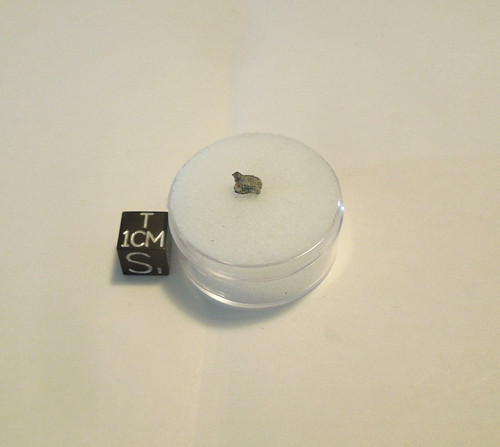On August 26, 2018, a bright and fast-moving fireball was seen over a remote part of the Libyan desert. Due to the chaotic nature of the political and military situation in Libya, it took over a year for the first meteorites to be recovered by intrepid local hunters. Stones eventually made their way onto the collector market under the informal name "Ghadamis".
Eventually, samples were delivered for analysis and it was officially classified as a L6 chondrite. Due to the lack of proper documentation of the recovery, this meteorite was classified as a "find, possible fall" although there is no doubt that was in fact a "witnessed fall". Specimens have the expected light-grey matrix with metal flecks and sparse chondrules. Fusion crust is black, fresh, and unoxidized. The official classified name for this meteorite is "Hammadah al Hamra 346" but it still sold as Ghadamis by some dealers.
Refer to the photo. The black centimeter cube is shown for scale and is not included. You are purchasing the fragment shown. It weighs approx. .173g (173mg). It is a part slice with visible metal flecks. Your purchase will include a labeled gemjar for safe storage.
From the Meteoritical Bulletin entry on HaH 346 :
Hammadah al Hamra 346 (HaH 346) 29°36’29.3"N, 13°22’03.4"E
Gharyan, Libya
Find, possible fall: 2018
Classification: Ordinary chondrite (L6)
History: On 26 August 2018, a large fireball was widely seen and heard around the sparsely populated region of the southern area of the Jabal al Gharbi District of Libya. Hundreds of freshly fusion crusted stones, totaling over 100 kg, were found in early 2019, scattered over several kilometers, about 95 km southwest of Ash Shuwayrif by Mr. Belal. S. Omar Aliby (and other meteorite hunters) who visited the site. The fusion crust is fresh and matte black and lacks evidence of extensive wind abrasion. Given the complete lack of weathering of the stones, it is possible that they originated from the 2018 meteor seen in this region. In 2019, Mr. Marcin Cimala purchased 30 kg of the material from a meteorite dealer based in Mauretania. Stones of this possible fall are currently being traded under the name of Ghadamis.
Physical characteristics: Many individuals from about 100 g to several kg, most unbroken stones are covered by matte black fusion crust. Many stones show well-developed shallow regmaglypts. Overall, the stones are blocky. Where fusion crust is lacking, the meteorite shows a light grayish interior. Specimen are very fresh; some show very minor brownish staining of exposed metal.
Petrography: (A. Greshake, MNB; L. Garvie, ASU) The meteorite displays a recrystallized texture predominantly composed of compositionally equilibrated olivine and low-Ca pyroxene grains in some regions showing 120-degree triple junctions. Few flattened and delineated PO, BO (to 1 mm), and relict PP chondrules are present. Matrix contains plagioclase, chromite, merrillite, troilite, taenite, and kamacite. The plagioclase grain size is about 60 µm. Shock melt veins are rare, but pockets are locally present. Fe-Ni metal and troilite uniformly distributed across the polished section. Largest Fe-Ni grain ~1 mm across. Most kamacite grains are polycrystalline and contains finely dispersed sub-micron-sized troilite. Some show a complex metal-sulfide eutectic intergrowth. A few larger kamacite grains show a frosty etch and weakly developed Neumann bands. Troilite, to 0.5 mm across, is highly shocked, polycrystalline, and has a dusty appearance. Cu metal was searched for but not found.
Classification: Ordinary chondrite L6, S5, W0





